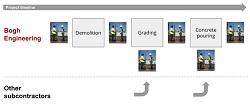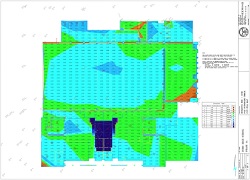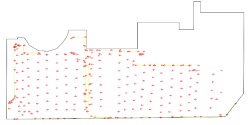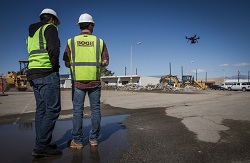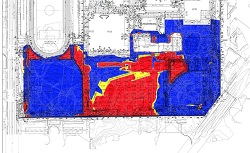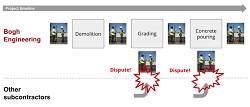How Drones Are Transforming Cut-and-Fill Workflows
BY KEVIN SARTORI
Headquartered in Beaumont, California, Bogh Engineering, an AGC of California and San Diego Chapter member, is a third-generation family owned construction and engineering company with 65 employees. It focuses on construction of public schools and is currently working on 14 jobsites including building the 1.4-million-sq-ft Indio High School. "Ninety percent of our business is focused on schools because we understand the business, the bureaucratic complications, and we can work directly with the client," says Mark Bogh, owner and a 30-year industry veteran.
Bogh Engineering’s core capability is pouring concrete, from flooring to vertical structures. The company also covers other activities to prepare a site for concrete construction: surveying, demolition and site grading. Site surveying is a recurring process and happens before and after every other major activity. Bogh Engineering also surveys the site before it takes over work from other subcontractors. Survey data make sure work starts as stated in the contract and is completed according to plan.
Site surveying happens before and after every other major activity.
Bogh Engineering employs its own survey crew that drives to each site and performs a topographic survey with traditional equipment. A survey of a school site usually takes one to two days for a one-man survey crew. "We needed a solution that helps us quickly and frequently run surveys. This was the initial trigger that made us look for a drone solution," Bogh says.
CREATING A CUT-AND-FILL ANALYSIS WITH TOPOGRAPHIC SURVEYING DATA
One of the largest projects Bogh Engineering is currently working on is the demolition and rebuilding of Indio High School in Indio, California. Work started in February 2013 and is now in the fifth and final phase. Before and after working on grading the site, the Bogh Engineering team surveys the site and uses the surveying data to perform a cut-and-fill analysis with Civil3D. Damian Garcia, staff engineer at Bogh, explains his workflow:
- Perform a topographic survey and collect points on a grid every 25 feet using a total station.
- Import the coordinates of all the measured points into Civil3D to create a topographic surface of the site.
- Create a design surface in Civil3D using the surface creation tools.
- Compare the z-dimension of this surface (existing grade) with the design subgrade of the plan.
- Areas that are between +/- 0.10 feet from the subgrade are considered correct and represented in green. Areas in blue indicate that the grade is too low and requires fill (or raise) in excess of +0.10 feet. Areas in red indicate that the grade is too high, and requires cut in excess of -0.10 feet.
Cut-and-fill analysis of a building pad in Phase 3 of the Indio High School project.
This view allows the team to have the complete picture on the work that needs to be done at the beginning of the project, or at the end, to check that the work has been completed as planned.
Earlier in 2017, Bogh Engineering started work on Phase 5 of the Indio High School project, which includes building two toilet/concessions buildings, one maintenance building, three new baseball fields, five basketball courts and a new parking. In this phase, the team is in charge of demolition, grading and building concrete.
To estimate how much dirt needs to be moved the team performs a cut-and-fill analysis. The surveyor spent two days on site and measured 324 points in total. Post-processing the data by a civil engineer in the office in Civil3D took another day.
The Bogh Engineering staff surveyor collected a total of 324 survey points on the Indio High School Phase 5 site using a total station.
FOURFOLD INCREASE IN PRODUCTIVITY WITH DRONES
Today, Bogh Engineering uses Site Scan, a drone data platform, to do surveying work. Flying the drone on the 17-acre site of Indio High School and collecting all the data takes only 30 minutes. During the two flights, they captured 410 images. These images were then processed into an orthomosaic and a 3D point cloud in about three hours.
Colin, certified FAA Part 107 pilot, surveying the phase 5 site.
The team had previously collected 10 ground control points at the beginning of the project in only one hour. The control points can now be imported into Site Scan Manager to georeference the model so that it can be overlaid with the subgrade. The same control points are left untouched on the ground and can be used to georeference any model from future flights.
The whole operation, from collecting the data and processing the images into 3D point clouds, took just half a day. This represents a fourfold increase in productivity on this specific site compared with traditional topographic surveying.
Bogh Engineering now only spends a fraction of the time in the field.
"Now, our processed data is also much more granular" says Damian Garcia. "The 3D point cloud of the Indio High School Phase 5 had 3 million points and allows for much more accurate cut-and-fill analyses."
Cut-and-fill analysis of Phase 5
SAVING TIME AND MONEY WITH BETTER DOCUMENTATION AND PREVENTING DISPUTES WITH OTHER SUBCONTRACTORS
In addition to flying the sites for bidding and checking its own work, Bogh Engineering started flying its drone to collect a comprehensive as-built picture of sites for documentation. Multiple companies are working on the same site together with Bogh Engineering and disputes between subcontractors happen all the time.
Disputes with other subcontractors happen at project handovers
This pushes Bogh Engineering to survey a site when it takes over work from another subcontractor to ensure that work has been completed according to the plan. This is important to avoid expenses that are beyond the scope of Bogh’s contract.
Bogh believes that having all important records accessible online saves the company time and money. Employees with the proper permission levels can access the weekly orthomosaic views, images and flight information. "If anything ever comes up, it’s a simple click to find month-old documentation of the site," says Bogh. "Especially orthomosaic views can help reconstruct an event and recognize what work has been done and when."
Bogh explains that he identified an error in trench work from another subcontractor just by looking at the orthomosaic view from the latest flight. He immediately sent the subcontractor's project manager a change order for $400 attaching the orthomosaic view as proof.
LOOKING FORWARD
Given the success they had in the first two months of using drones, the Bogh team wants to increase the frequency and fly every site once a week to collect data for documentation.
Weekly orthomosaics from the sites will give the team the necessary data to better communicate with other subcontractors and have proof in case of disputes. "The biggest advantage of all is that now we can prevent these unpleasant situations from even happening. Having views of the site does not only allow my team to react proactively and warn other subcontractors that errors have been made, but it also speeds up collaboration with them."
"I’ve showed other contractors the data collected and how easy it is to implement into what they do every day," he adds. "Every small engineering firm should own one."
Kevin Sartori is a senior product marketing manager at 3DR, which makes Site Scan, a complete drone data platform. Sartori is a robotics engineer by training based in Berkeley, California At 3DR, he combines his passion for helping clients improve their businesses with UAVs.
The Associated General Contractors of America
http://www.acg.org/
